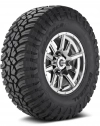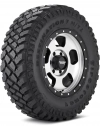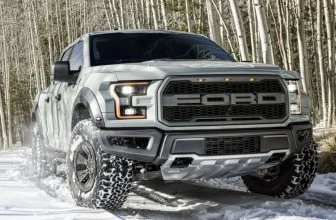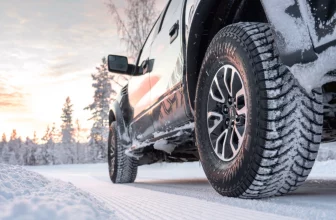Each manufacturer has optimized the design and internal construction of the tires for maximum mud traction and befitting highway comfort. The best off-road tires for mud and rocks do not have to cost you a fortune. Drivers can choose an affordable, maximum traction option from a variety of brands.
Off-road driving conditions can be treacherous. The wrong choice of tires is a recipe for poor handling and all the safety risks associated with poor traction. Often, drivers will go after all-terrain tires, which offer balanced performance on the highway and off-road.
Deep mud and loosely packed roads still present a challenge to all-terrain tires. Only mud tires can conquer these rugged roads with ease, also boasting good rock-crawling capabilities.
Apart from superior off-road performance, mud tires offer drivers decent performances when cruising on the highway. Their aggressive tread patterns allow driving over any road. The mud tire market is flooded with different alternatives.
| Tire name | Best in Category | Overall rating | Steering response | Wet performance | Hydroplaning resistance | Wet traction | Dry performance | Cornering stability | Dry traction | Comfort performance | Ride quality | Noise score | Treadwear performance |
|---|---|---|---|---|---|---|---|---|---|---|---|---|---|
| General Grabber X3 | 100% | 9 | 8.7 | 8.9 | 9 | 8.7 | 8.9 | 8.8 | 9.3 | 8.4 | 8.8 | 8 | 8.6 |
| Firestone Destination M/T2 | 98% | 9 | 8.7 | 8.1 | 8.4 | 7.9 | 8.9 | 8.7 | 9.4 | 8.4 | 8.9 | 7.8 | 8.7 |
| BFGoodrich Mud-Terrain T/A KM3 | 98% | 9 | 9 | 8.7 | 8.9 | 8.5 | 9.1 | 9 | 9.2 | 8 | 8.8 | 7.2 | 8.6 |
| Kumho Road Venture MT KL71 | 90% | 8 | 8.2 | 8 | 8.1 | 8 | 8.4 | 8.1 | 8.9 | 7.4 | 7.9 | 7 | 7.3 |
| Goodyear Wrangler MT/R with Kevlar | 88% | 8 | 8.3 | 8.1 | 8.2 | 8.1 | 8.4 | 8 | 8.9 | 6.8 | 7.3 | 6.2 | 6.6 |
What is the Exact Reason You Need Mud Tires?
Any driver who has ventured into muddy or rocky off-roads understands the stress brought forth by poor traction. Chances are, the tires will begin spinning, your vehicle gets stuck in the mud, and in extreme cases, you damage the suspension or drivetrains.
Mud-terrain tires are specifically designed for maximum mud and rock performance to give you confidence when driving over muddy, slippery, or rocky surfaces. The tread pattern and design ensure that the tires grip firmly onto the surface to provide you with better handling and responsiveness to steering controls for a safe and predictable off-road adventure.
The best off-road tire for mud and rock should allow you to drive over mud and any other slippery surface comfortably.
What Type of Vehicle Do You Need to Conquer Mud and Rocks (4×4)
Drivers of SUVs, pickup trucks, jeeps, and other 4×4 often take their vehicles for an off-road ride. These vehicles deliver the proper torque required to maneuver through challenging terrains. They come with elevated suspensions for an ultimate off-road adventure. If you own any of these vehicles and wish to venture into the rough off-road terrains, then you should find a set of mud-terrain tires.
Top-Rated Off-Road Tires for Mud and Rocks
General Grabber X3
This is a maximum traction tire with an aggressive, symmetric tread pattern meant to protect drivers against the troubles of the muddy off-road. The treads are highly voided and contain full-depth sipes. The tires have sufficient protection against hydroplaning and rely on DURAGEN Technology for extended durability.
General Grabber X3Editor choice
Firestone Destination M/T2
These tires utilize wear-resistant rubber compounds to form a highly voided tread pattern. Terrain attack angle is kept at 23O. The serrated upper sidewall ensures maximum traction is achieved when driving over mud. A strong internal casing protects the tires against punctures. The tires contain mud ejectors that enhance the self-cleaning capabilities of the tires.
Is Firestone Destination M/T2 a Good Tire?Editor choice
BFGoodrich Mud-Terrain T/A KM3
These tires utilize Krawl-Tek rubber compounds and terrain-attack tread design for ultimate grip on rocks, muddy and slippery roads. The sidewalls are reinforced for better protection. Notched shoulders improve the traction capabilities of the tire over loose surfaces. Wide grooves provide sufficient protection against hydroplaning while the tough internal construction guarantees durability.
BFGoodrich Mud-Terrain T/A KM3 Tire ReviewEditor choice
Kumho Road Venture MT KL71
The tires use a chip-resistant rubber compound which is molded into a directional tread pattern. Alternating shoulder blocks, aggressive shoulder lugs, and packed center blocks provide maximum mud traction. The internal construction features 2-ply polyester cords and 2 high-tensile steel belts for better durability and stability.
Kumho Road Venture MT KL71Editor choice
Goodyear Wrangler MT/R with Kevlar
The tires are manufactures from high-silica content rubber materials for optimum durability. They use Goodyear’s Mudflow geometry which enhances their self-cleaning capabilities. Kevlar material enhances the strength and puncture resistance capabilities of the tires. They feature shoulder blocks and wrap-around treads on the sidewalls for maximum mud-traction.
Goodyear Wrangler MT/R with KevlarEditor choice
What to Look for When Buying the Best Tires for Mud and Rocks
What type of tire tread is best for muddy off-road surfaces? (deep tread blocks)
There are several uncertainties when it comes to off-road driving. You are not sure about the depth of the muddy sections or how much time you will spend on rock crawling.
Regardless of these conditions, it is critical to have the best off-road tires to maintain a sufficient footprint on different surfaces. Mud-terrain tires feature deep treads with extensive and flexible tread blocks. Other mud-terrain tires contain alternating tread blocks.
When driving on muddy roads, dirt is will likely stick between the wide tread voids. The accumulation of dirt reduces the tires’ biting edges, making them lose traction against loosely packed, slippery, or muddy roads.
Mud-terrain tires are self-cleaning. They remove debris and dirt from the grooves. Other maximum terrain tires have lugs and treads on the sidewalls that improve their traction capabilities. Tread patterns will vary from brand to brand, with most tires featuring symmetrical tread patterns.
What Types of Mud Will You Be Driving in?
The quantity of mud on the road depends on the type of surface soil and the quantity of water on the road. Off-road driving will expose drivers to sticky roads, which are predominantly clay surfaces. Clayey mud is typically thick. The tires sink deep into the mud. Tires with thinner treads are likely to spin on these surfaces.
Some road conditions will involve driving over loosely packed roads containing water. The mud will often be thin. Driving over light mud with maximum traction tires is not challenging as going over thick mud. Hardpacked surfaces like gravel roads, loose soils or dirt, and sand roads are also treated as mud surfaces. The roads turn sticky when there are puddles of water on the roads.
Maximum Traction Off-Road Tires are the Best Alternative
The design of all-terrain tires focuses on balanced highway and off-road performance. All-terrain tires feature reinforced sidewalls, which perform well on most hardpacked surfaces, dry tarmac, and wet roads. However, they are not a reliable choice when driving your 4×4 vehicle over deep mud or crawling over larger rocks.
Harsh road conditions like deep mud, slippery surfaces, and larger rocks pose challenges to all-terrain tires. On the contrary, mud-traction tires are engineered for modest highway stability and performance and superior off-road capabilities.
They have a stricter sidewall, use advanced, tear- and cut-resistant rubber compounds, and have sufficient protection against puncturing. The aggressive tread patterns, large tread blocks, and solid internal constructions improve handling characteristics. Drivers can handle their vehicles when rock crawling as though they are driving on dry tarmac.
Mud terrain tires can dig into deep mud and drive with ease. All-terrain tires perform well over thin mud. Mud-terrain tires are available in multiple standard sizes. They also have all-season capabilities meaning that they can be driven over snow. In general, mud-terrain tires combine the capabilities of a highway tire, off-road tire, summer, and winter tires into one product.
Mud-Terrain Tires are Excellent for Rock Crawling as Well
Rock crawling has its fair share of challenges. There is a high probability of puncturing, wear, and tear caused by sharp or abrasive rocks. The tires do not have an even footprint when driving over unevenly shaped boulders. As a result, there is low traction with the road surface, compounding handling, and steering challenges.
Mud terrain tires are a modest option for drivers interested in rock crawling. Most tires adopt a terrain attack angle and feature a series of large and deep tread locks. The treads are made from tough yet flexible rubber materials. That way, the tires can maintain traction with the rocky surfaces.
Internal tire casings use strands of steel belts, polyester cords, and nylon reinforcements which increase the inner toughness of the tires. They protect the tires against premature damage. Stone ejectors remove small debris from the treads. When choosing tires for rock crawling, examine the size of tread blocks and the resilience of the tread compounds.
Some All-Terrain Tires Might be a Good Option for Amateur Rock Crawlers
Drivers have mixed experiences when driving over rocky roads. Experienced rock crawlers can efficiently respond to terrain changes. The same cannot be said for amateur rock crawlers. At first, you will feel that you have lost traction with the surface. Larger rocks will make steering more challenging.
However, the best mud-terrain tires for mud and rocks can turn your initial off-road venture into a memorable one. Tires with large tread blocks, an aggressive tread pattern, and strong rubber materials will retain sufficient grip with the rocky surface to give amateur rock crawlers a decent and responsive ride.
Popular Questions about Mud-Terrain Tires
Do Mud Terrain Tires Work In The Snow?
Mud-terrain tires are manufactured with deep voids between treads. The optimized tread patterns provide additional biting edges to facilitate snow-on-snow traction.
The tires expel trapped snow efficiently. Mud-terrain tires offer predictable handling and good responsiveness to steering controls when driving on snow. These tires are a good option for snow driving.
What Mud Terrain Tires Last The Longest?
The durability of mud-terrain tires depends on your driving habits. On dry tarmac, these tires tend to wear faster. One of the best mud-terrain tires for mud and rock which last longest is Goodyear Wrangler MT/R with Kevlar which uses a strong rubber material. The high silica tread material is wear-resistant for maximum and extended traction.
Are Mud-Terrain Tires Good On The Road?
Mud-terrain tires are primarily aggressive tires. They are designed for extreme off-road conditions. It means that manufacturers focus on off-road capabilities with little attention to highway comfort. These tires are therefore noisy and unbalanced on dry tarmac. They are appropriate for short on-road driving.
Are Skinny or Wide Tires Better for Mud?
Muddy surfaces are slippery and soft. When driving on mud, it is better to use wide tires. They have better floatation. Wide tires provide wider contact patches to decrease pressure on the lugs. Wide tires are equally vital for sand, loosely packed surfaces, and gravel.
Are Off-Road Tires Noisy?
The design of most off-road vehicles sacrifices on-road comfort for better off-road performance. The tires have large tread blocks and aggressive tread patterns. On the highway, the tires will generate a lot of noise. They have poor ride quality and comfort compared to highway tires.
Which are Better Mud tires or All-Terrain?
Mud-terrain tires are a better choice. Although all-terrain tires strike a good balance between highway performance and off-road ventures, they exhibit lower capabilities when driving in mud and rocky terrains. Mud-terrain tires provide maximum traction and better protection against puncture, wear and tear when crawling on rocks.
Are Mud Tires Bad in Rain?
Most mud-terrain tires lack sipes. On the other hand, they have deep circumferential grooves required for expelling surface runoffs.
Mud-terrain tires have lower wet traction than highway tires. They are difficult to handle when driving over the wet tarmac. Generally, these tires are not the preferable option when driving in the rain.
Do Mud Tires Get Worse Gas Mileage?
Mud-terrain tires feature an aggressive tread pattern — wide blocks and lugs. They increase the rolling resistance of the tire.
It is essential to keep the tires well inflated when driving on the highway. By comparison, drivers have to spend more on fuel when driving on mud-terrain tires instead of highway tires.











